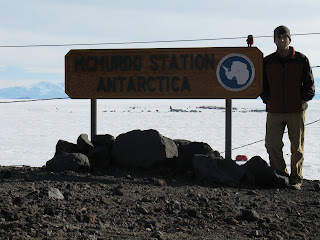Loading up on the LC-130 airplane
Greetings from WAIS Divide everyone. We finally made it in last week and got some internet up and running. Here are a few highlights from the first week.
I set up my tent right on the snow, and this year I even got a cot to put my sleeping bag on. It get's pretty cold at night, but our bags are rated for -50 degrees so I stay toasty warm. Another thing that is common down here, is to fill up a water bottle with some hot water and to sleep with it. As you can see, I have plenty of room to move around and get changed in the morning.
This is one of the welcoming signs here at WAIS Divide. You can see most of the camp buildings behind me. Just in front of me is the skiway where the planes land.
One of the nice things about life at WAIS Divide, is that we have a 4 star chef cooking for us! We had an enormous thanksgiving dinner and even had 7 different pies!
One of the electricians, J.P. built an igloo all by himself by cutting out blocks of snow with a handsaw.
Once we started working in the ice core drilling arch, we boxed up ice cores from last season into insulated containters and put them on pallets for shipment. So far, we have already shipped over 500 ice cores from last season.
Here is a veiw of some of the camp buildings. Pictured here are a communications building, a science building, the galley (where we eat), and the wash module (where we brush our teeth and shower)
One of the other scientists, Bess, had her birthday down here and the cooks made her two huge birthday cakes!
Another science group came through WAIS Divide that will be leaving tomorrow. They are doing seismic studies on the ice sheet. This means that they drill small holes and ignite small explosives down the holes. They then record how long it takes for the shockwaves from those explosives to go through the ice sheet. This tells them how thick it is. In this pic, they are testing their small drill outside of camp.
Here is rebecca getting ready to head out of camp on her ski-doo
Here are two more scientists ready to head out of town, with a nice shot of the Basler plane parked behind them.
Both the basler and an LC-130 parked on the skiway. WAIS International
airport!























































